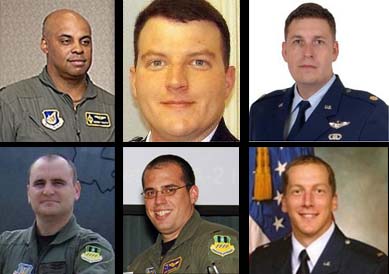The Air Force yesterday announced it had formally declared that all six airmen had died in the B-52 crash off the northwest coast of Guam on July 21. Search and rescue crews found the bodies of two airmen on July 21, and by July 23 they shifted from round-the-clock rescue operations to recovery mode. Five of the six airmen on board had deployed to Andersen AFB, Guam, from the 2nd Bomb Wing at Barksdale AFB, La. The sixth was a flight surgeon assigned to the 36th Medical Group at Andersen. The Barksdale airmen were: Maj. Christopher M. Cooper, 33, aircraft commander; Maj. Brent D. Williams, 37, navigator; Capt. Michael K. Dodson, 31, co-pilot; 1st Lt. Joshua D. Shepherd, 26, navigator; and 1st Lt. Robert D. Gerren, 32, electronic warfare officer. From Andersen was Col. George Martin, 36th MDG deputy commander. The massive rescue operations covered a 7,000-square mile area and included Air Force, Coast Guard, and Navy search teams and Guam emergency services personnel. “Losing this bomber crew has been a tragedy felt by everyone here and across the Air Force,” said Brig. Gen. Douglas Owens, 36th Wing commander, and added, “I extend our sincerest gratitude to the men and women involved with this [rescue and recovery] effort.” The 2nd Bomb Wing commander, Col. Robert Wheeler, said in a subsequent release, “We appreciate the military and civilian organizations who are continuing recovery efforts to bring our airmen home.”
Air Force yesterday announced it had formally declared that all six airmen had died in the B-52 crash off the northwest coast of Guam on July 21. Search and rescue crews found the bodies of two airmen on July 21, and by July 23 they shifted from round-the-clock rescue operations to recovery mode. Five of the six airmen on board had deployed to Andersen AFB, Guam, from the 2nd Bomb Wing at Barksdale AFB, La. The sixth was a flight surgeon assigned to the 36th Medical Group at Andersen. The Barksdale airmen were: Maj. Christopher M. Cooper, 33, aircraft commander; Maj. Brent D. Williams, 37, navigator; Capt. Michael K. Dodson, 31, co-pilot; 1st Lt. Joshua D. Shepherd, 26, navigator; and 1st Lt. Robert D. Gerren, 32, electronic warfare officer. From Andersen was Col. George Martin, 36th MDG deputy commander. The massive rescue operations covered a 7,000-square mile area and included Air Force, Coast Guard, and Navy search teams and Guam emergency services personnel. “Losing this bomber crew has been a tragedy felt by everyone here and across the Air Force,” said Brig. Gen. Douglas Owens, 36th Wing commander, and added, “I extend our sincerest gratitude to the men and women involved with this [rescue and recovery] effort.” The 2nd Bomb Wing commander, Col. Robert Wheeler, said in a subsequent release, “We appreciate the military and civilian organizations who are continuing recovery efforts to bring our airmen home.”
Pentagon Releases Cost of Living, BAH Rates for 2026
Dec. 30, 2025
The Pentagon will pay cost of living allowances to 127,000 service members in the continental U.S. in 2026, an increase of 66,000 members in 2025. Airmen and Guardians across the U.S. will also receive an average increase of 4.2 percent for their Basic Housing Allowance, compared to the 5.4 percent…

